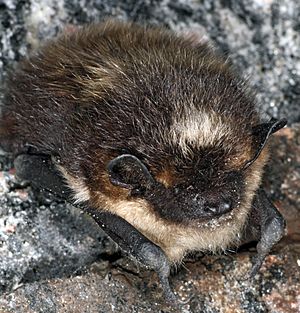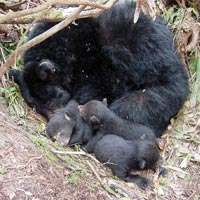Hibernation facts for kids

Hibernation is a special way some animals deal with tough times, usually during winter. It's like a very deep sleep where they become inactive. Animals that hibernate are often warm-blooded (meaning they can control their body temperature). They do this when food is hard to find.
During hibernation, an animal's body changes a lot. Their body temperature drops, their breathing slows down, and their heart beats much slower. This helps them use less energy. They live off the fat they stored in their bodies during summer and autumn.
Many different animals hibernate. These include bats, ground squirrels (like marmots), hedgehogs, and some marsupials. Even some insects, like certain wasps, have periods of inactivity that are similar to hibernation. For reptiles, this winter rest is often called brumation.
Contents
Why Animals Hibernate: A Look at Evolution
Animals first started hibernating as they moved from the ocean onto land. In the ocean, temperatures are usually steady. But on land, seasons change a lot, especially winter. These big seasonal changes, like cold weather and less food, pushed animals to find ways to survive. Hibernation became a great way to do this. The colder and longer the winter, the longer animals tend to hibernate.
Mammals That Hibernate
Primates and Hibernation
For a long time, scientists thought only rodents like ground squirrels hibernated. But then they found out about the fat-tailed dwarf lemur in Madagascar. This lemur hibernates in tree holes for seven months each year! Even though Madagascar can be warm (sometimes over 30°C or 86°F), this lemur still hibernates. This shows that hibernation isn't just about super cold temperatures. It also depends on how well their tree hole keeps them warm.
Do Bears Really Hibernate?
For a while, people wondered if bears truly hibernate. Their body temperature only drops a little (about 3-5°C or 5-9°F), which is not as much as other hibernating animals (who drop 32°C or more). But recent studies show that bears do go into a deep, sleep-like state. They can even recycle their body's proteins and urine, which means they don't need to pee for months and their muscles don't get weak. This is pretty amazing!

Obligate Hibernators: The Deep Sleepers
Some animals are called "obligate hibernators." This means they have to hibernate every year, no matter how warm it is or how much food is around. Many ground squirrels, other rodents, mouse lemurs, and the European hedgehog are examples. Even some butterflies, like the small tortoiseshell, do this.
When these animals hibernate, their body temperature drops very low, almost to the temperature of their surroundings. Their heart and breathing rates slow down a lot. They usually wake up for short periods during the winter. Scientists are still trying to figure out why they do this. Some ideas are that they need to wake up to sleep properly, to get more energy, or to keep their immune system working.
For example, the Arctic ground squirrel can have a body temperature as low as -2.9°C (26.8°F) in its belly for weeks! But its head and neck stay a bit warmer, around 0°C (32°F) or above.
Facultative Hibernators: Hibernating When Needed
Unlike obligate hibernators, "facultative hibernators" only hibernate if they are very cold, don't have enough food, or both. A good example is the difference between two types of prairie dogs: the white-tailed prairie dog must hibernate, but the black-tailed prairie dog only hibernates if conditions are bad.
Birds and Their Winter Rest
Most birds don't hibernate. Instead, they often use something called torpor. This is a shorter period of inactivity where their body temperature and metabolism drop, but not as deeply or for as long as true hibernation. One bird that is known to truly hibernate is the common poorwill.
Fish and Dormancy
Fish are cold-blooded, meaning their body temperature changes with the water around them. So, they can't actively control their body temperature to hibernate like warm-blooded animals. However, in very cold water or when there's not much oxygen, their bodies can slow down a lot. This is a type of dormancy, but it's not the same as hibernation.
Brumation in Reptiles
Reptiles are also cold-blooded. For them, very cold temperatures can be dangerous. So, they developed "brumation," which is their version of winter dormancy. Brumation helps reptiles survive cold weather. Reptiles that brumate often live longer and age slower.
Unlike mammals, reptiles actively choose to cool their bodies down. They look for colder places to rest based on an internal clock, which is likely triggered by cooler outside temperatures. The Texas horned lizard is a good example of this behavior.
Could Humans Hibernate?
Scientists are studying if humans could ever hibernate. This ability could be very useful! For example, it might help save seriously ill or injured people by putting them into a temporary hibernation state until doctors can treat them. Human hibernation is also being considered for long space missions to Mars.
Related pages
Images for kids
See also
 In Spanish: Hibernación para niños
In Spanish: Hibernación para niños



